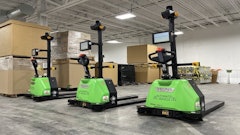Consumers are fickle, picky, hard-to-please, even harder to predict, and prone to disappoint. But they also drove $3.6 trillion in retail sales last year in the United States alone, according to U.S. Census Bureau statistics. As a result, the hard-pressed players in the retail sector remain laser-focused on getting the right product onto the right shelf at the right time.
But industry observers say that leading companies in the sector are shifting their attention from managing the movement of products through the supply chain to better managing the flow of information about those products. For retailers and their manufacturer suppliers mastering the data challenge is proving to be the key to improving supply chain performance.
For some perspective on this challenge, in the wake of the recent National Retail Federation conference in New York, Supply & Demand Chain Executive spoke with a cross-section of executives with experience in various segments of the retail supply chain.
Transforming Data
Thom Jones' perspective on the retail supply chain is, by his own admission, influenced by his current post with Little Neck, N.Y.-based Leviton Mfg. Co. Inc., a leading North American supplier of electrical and electronic products to the retail sector. "Since my position is vice president of materials management," says Jones, "I'm very much focused on inventory and forecasting." And, Jones continues, the key to ensuring high inventory turns and accurate forecasting, is transforming data — whether from point-of-sale (POS) systems or inventory and production control systems — into useful information that planners can use to predict consumption at the store level for each of the company's 25,000-plus stock-keeping units (SKUs).
Leviton has been using a suite of demand planning solutions from St. Louis-based Demand Management Inc. (DMI), a subsidiary of Logility, to manage the retail side of its business. The manufacturer is using DMI's Demand Solutions Forecast Management (DS FM) application as a forecasting engine and data warehouse; the DS Requirements Planning solution, for demand requirements planning; DS Feedback, to collect the sales force's frontline feedback on forecasts; and DS Stores, a point-of-sale analysis tool with vendor-managed inventory functionality. While Leviton currently does not use the VMI capabilities of DS Stores, it is using the analytical tool to transform the data from retail customers' POS systems into information that will be useful for the company's planners.
The Feedback application has proved important on the retail side of Leviton's business, Jones says, because of the high level of involvement by the company's marketing and sales groups in the forecasting process. "There are a lot of promotions, modifications to the product sets, changeovers in packaging and product planning that can greatly impact how much inventory we need to carry at any time," Jones explains, "so our forecasts need to be very closely watched on those items, and our inventory management needs to be co-handled."
Another challenge that the company faces specifically on the retail side is working with the large central buying offices at its major retail customers. "You can feel the repercussions of a central buying office placing a single batch of orders for the entire nation, which could amount to many months of supply on their normal ordering patterns," Jones says. Leviton prides itself on being able to respond to those high-impact orders with inventory on hand, but to be cost effective the company maintains additional production capacity so it doesn't have to carry excess inventory. In addition, Jones notes that the central buying offices represent an opportunity for Leviton to work more closely with its customers, using the POS data coming in from the customers to help those buying offices understand which inventory, and how much inventory, should go where within the customer's store system. "The point-of-sale analysis enables us to look at different products that sell better in different areas of the country, so that we can address those items to the central office and say that this area needs to stock more of this inventory, and this area needs to address this inventory situation," Jones says.
He is quick to add, however, that he fully respects the customers' desire to control their own inventories and to own the management of that inventory. But Jones believes that the analytical capabilities of the demand planning solutions present an opportunity for retailer and manufacturer to collaborate more closely to optimize inventory levels across the supply chain. "We know the product very well, and they know their business very well, and together I think that we can develop a result that's going to yield high service levels to their customers, which are really our customers in the end," he says.
Mastering Product Cycles
Collaboration around data also is on the mind of Dave Haskins, who is executive vice president of development with Webplan, a provider of Web-based planning solutions for manufacturers.
As Haskins sees it, product cycles in the retail sector are simply getting too short, particularly in red-hot segments like consumer electronics. At the same time, supply chains in the consumer sector are becoming elongated as manufacturers increasingly source components or entire products offshore. "Because of the distributive nature of the supply chain and the variability inherent in more retail-oriented products, the biggest challenge that companies are facing is the level of complexity involved in the whole business process around managing a demand change and then being able to quickly determine the supply chain cost of that change," says Haskins.
Haskins points out that the new extended consumer supply chain involves original equipment manufacturers (OEMs) that don't actually manufacture much, or most,
of their products anymore, and contract manufacturers (CMs) that stand one, two or more tiers away from end customers. This disconnect sets up a natural tension: For the OEMs, the imperative is to continuously introduce new widgets to take advantage of the burst of consumer demand and premium prices that the latest and greatest gizmo can command; but for the CM, the objective is to control costs and reduce inventory exposure to a minimum. This tension has tended to play out in the negotiations between the two parties over who pays how much for the level of flexibility necessary to respond to rapid changes in consumer demand, and if the two parties have collaborated, their work together has been primarily to try to synchronize their respective plans.
But this adversarial approach ignores the real issue, Haskins asserts. "It's not about a planning problem," he says, "because there's a limit to how far you can go with trying to maintain some kind of synchronization of plans." Rather, Haskins calls on OEMs and their contract manufacturers to work together, using a Response Management-type solution like Webplan's, to create a unified plan that can incorporate both demand signals coming into the OEM and inventory and production capacity data from the CMs. (Other solution providers offering this "single set of data" approach include Adexa, Demantra, Prescient Systems and Supply Chain Consultants). Establishing this sort of "single version of the truth" would allow the parties to come to a shared understanding of the costs of flexibility in the supply chain. "The OEM may be focusing on making sure that the forecast is accurate, whereas the CM is making sure that the supply side information is accurate or looking at what kinds of constraints they might have to meet a demand change, but the key is that both parties are able to look at the same thing."
From "Clobberation" to Collaboration
Lori Mitchell-Keller also believes that greater collaboration is increasingly a requirement in the retail supply chain, and she says that consumers' capricious nature makes this sort of closer retailer-supplier relationship more of a necessity. As evidence, Mitchell-Keller, who is senior vice president of global marketing and solution management at supply chain solution provider Manugistics, points to a survey, commissioned by her company and unveiled at the National Retail Federation conference, which revealed that during the most recent holiday season 58 percent of Americans who did not find the item they were shopping for on the shelf at one store walked out the door and went elsewhere. (Similarly, Stephen David, chief information officer and business-to-business officer at Cincinnati, Ohio-based Procter & Gamble, has cited figures suggesting that 75 percent of the time, out-of-stocks result in no sale.)
As an example of how retailers and their suppliers might address some portion of this challenge, Mitchell-Keller suggests that the two parties could work together more closely on pricing and promotions management to better manage the behavior of consumers hooked on sales and discounts. Scott Langdoc, a vice president for research with AMR Research, has pointed to the need for greater use of what he calls lifecycle retail price management (LRPM) software — offered by such solution providers as Manugistics, KhiMetrics and DemandTec, as well as IRI, KSS, SoftSolutions and i2 Technologies — as "a critical component of any retailer's profitable differentiation strategy."
But Mitchell-Keller cautions that just having the right tool in place at either the retailer or the supplier is not enough, and she warns of the danger of "clobberation," a term that she says a colleague at Manugistics uses to describe situations in which a "channel master" uses its 800-pound-gorilla status to force its own terms and conditions on its trading partners. A retailer may achieve some level of benefit by throwing massive amounts of POS data "over the wall" and mandating that suppliers run the data through an analytical tool to ensure high in-stock levels. However, the retailers and suppliers would be better served by creating a collaborative work process to reach a shared understanding of what the data mean. "It's not just a matter of one portion of the supply chain having the data and one portion of the supply chain having the tools. It really is a matter of the extended network using those tools and the data in combination," Mitchell-Keller concludes.















